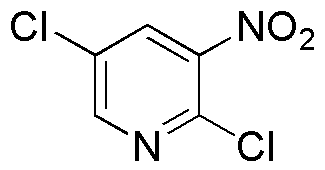2,5-Dichloro-3-nitropyridine is widely utilized in research focused on:
- Pesticide Development: This compound serves as a key intermediate in the synthesis of various agrochemicals, particularly herbicides and insecticides, helping to enhance crop protection and yield.
- Pharmaceutical Research: It is used in the synthesis of pharmaceutical agents, contributing to the development of new medications that target specific diseases, particularly in the field of anti-infectives.
- Dyes and Pigments: The chemical is employed in the production of dyes, providing vibrant colors for textiles and other materials, which is essential for the fashion and manufacturing industries.
- Material Science: It plays a role in creating advanced materials, including polymers and coatings, that offer improved durability and resistance to environmental factors.
- Analytical Chemistry: This compound is utilized as a reagent in various analytical techniques, aiding researchers in the detection and quantification of other chemical substances.
General Information
Properties
Safety and Regulations
Applications
2,5-Dichloro-3-nitropyridine is widely utilized in research focused on:
- Pesticide Development: This compound serves as a key intermediate in the synthesis of various agrochemicals, particularly herbicides and insecticides, helping to enhance crop protection and yield.
- Pharmaceutical Research: It is used in the synthesis of pharmaceutical agents, contributing to the development of new medications that target specific diseases, particularly in the field of anti-infectives.
- Dyes and Pigments: The chemical is employed in the production of dyes, providing vibrant colors for textiles and other materials, which is essential for the fashion and manufacturing industries.
- Material Science: It plays a role in creating advanced materials, including polymers and coatings, that offer improved durability and resistance to environmental factors.
- Analytical Chemistry: This compound is utilized as a reagent in various analytical techniques, aiding researchers in the detection and quantification of other chemical substances.
Documents
Safety Data Sheets (SDS)
The SDS provides comprehensive safety information on handling, storage, and disposal of the product.
Product Specification (PS)
The PS provides a comprehensive breakdown of the product’s properties, including chemical composition, physical state, purity, and storage requirements. It also details acceptable quality ranges and the product's intended applications.
Certificates of Analysis (COA)
Search for Certificates of Analysis (COA) by entering the products Lot Number. Lot and Batch Numbers can be found on a product’s label following the words ‘Lot’ or ‘Batch’.
*Catalog Number
*Lot Number
Certificates Of Origin (COO)
This COO confirms the country where the product was manufactured, and also details the materials and components used in it and whether it is derived from natural, synthetic, or other specific sources. This certificate may be required for customs, trade, and regulatory compliance.
*Catalog Number
*Lot Number
Safety Data Sheets (SDS)
The SDS provides comprehensive safety information on handling, storage, and disposal of the product.
DownloadProduct Specification (PS)
The PS provides a comprehensive breakdown of the product’s properties, including chemical composition, physical state, purity, and storage requirements. It also details acceptable quality ranges and the product's intended applications.
DownloadCertificates of Analysis (COA)
Search for Certificates of Analysis (COA) by entering the products Lot Number. Lot and Batch Numbers can be found on a product’s label following the words ‘Lot’ or ‘Batch’.
*Catalog Number
*Lot Number
Certificates Of Origin (COO)
This COO confirms the country where the product was manufactured, and also details the materials and components used in it and whether it is derived from natural, synthetic, or other specific sources. This certificate may be required for customs, trade, and regulatory compliance.


